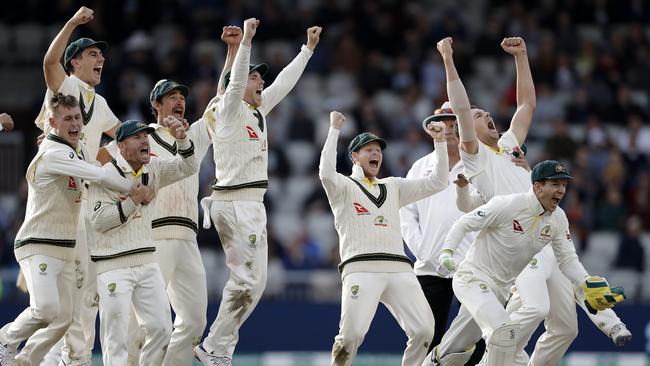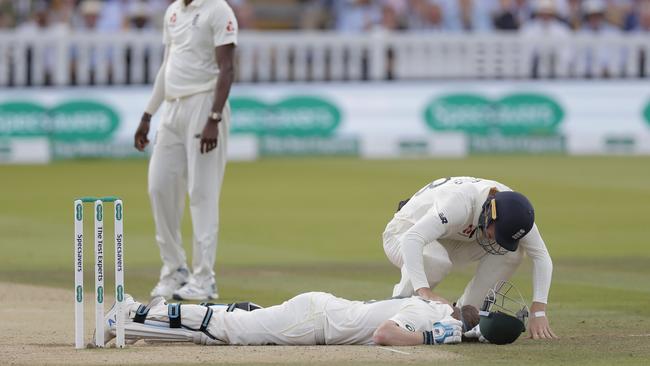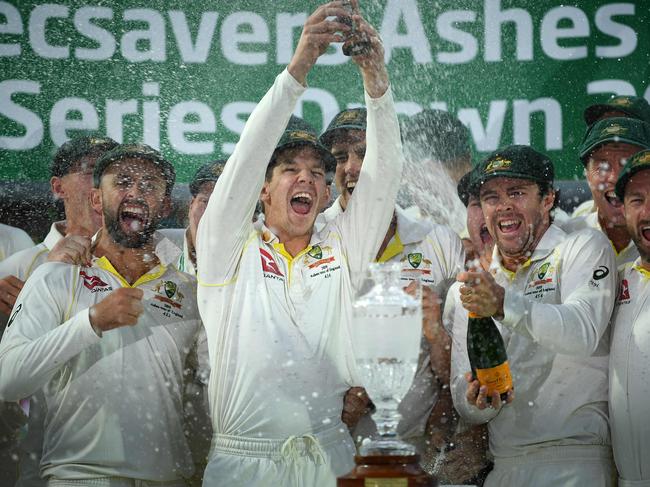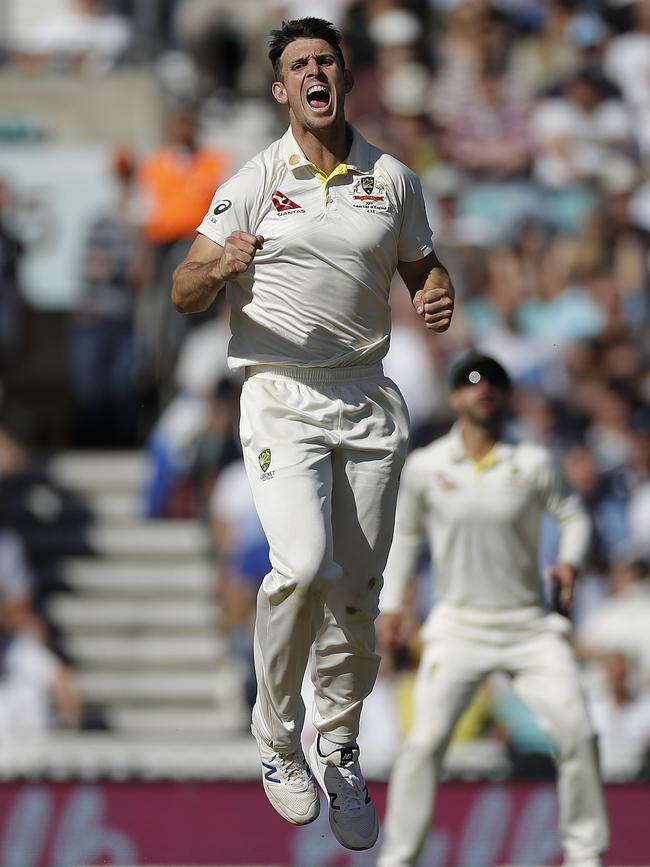The Ashes 2023: Gideon Haigh reflections on 2019 contest
Can the classic 2019 contest, as remembered by The Australian’s chief cricket writer Gideon Haigh, predict what’s to come?

Not often does the promotion of a cricket match, and a Test match at that, condense to the clash of two cricketers. Very seldom indeed does that competition then fulfil the expectation. But for an hour at Lord’s on August 17, 2019, Day Four of the Second Ashes Test, Australia and England had second billing, and the Ashes were left to gather dust on the mantelpiece.
The duel, amply promised for the preceding week, was afoot: Steve Smith versus Jofra Archer. At lunch, the records still seemed to be forming an orderly queue for Smith’s delectation. He had become the first man to accumulate seven consecutive Ashes fifties; he was within sight of the rare feat of registering three consecutive Ashes centuries. Australia had lost a solitary wicket in the first session, and the sun was out on a day where the light otherwise fluctuated like an expiring neon tube.
Then came Archer, his international career just two months old, three days into his first Test, from the Pavilion End.

The great Viv Richards famously scorned to wear a helmet on grounds that it involved acknowledgement that a bowler was fast, but would allow that a certain bowler was “serious”. Archer is serious. It’s fortunate that the consequences of his spell after lunch were not more so. The speeds the scoreboard flashed were more reminiscent of a sports car than an English pace bowler: sixteen consecutives were clocked, in cricket’s defiantly imperial way, at more than 90mph.
The fastest, at 96.1mph, was 155km/h in the new money. Jack Leach’s contrastingly gentle arcs were measured at half that speed. But you did not need radar to sense the rapidity. Archer’s tightness to the stumps and the gradient of the ground added a serration to his sharp edge: he jagged a ball back that rendered Tim Paine helpless, then released a bouncer that did the same to wicket-keeper Jonny Bairstow.
Before the match Australia’s coach had cast doubt on his stamina, his capacity to sustain velocities amid the hard grind of Test cricket. “I think Justin Langer has another thing coming,” Archer had retorted, and now added deed to word.
Above all, for the first time this series, Smith’s jerks and jives seemed to have more external than internal influences. Archer had Smith playing and missing; Archer had Smith fending; Archer had Smith hooking in the air. At length, he hit Smith’s arm, raising an angry haematoma that required an X-ray.
At last, he hit Smith’s neck, laying him out face down.
The innocent days when batsmen shrugged off blows with a shake of the head and the replacement of a helmet are long ago. Nothing has seemed the same since Phillip Hughes was laid to rest, not least for the four occupants of Australia’s dressing room present that fateful day. Nowadays – quite rightly – there is immediate concern. As Smith crumpled, medical staff hurried from both benches. A photograph captured him with his eyes closed. An overhead camera showed him laid out like a flattened fighter in a ring. For a moment the World Test Championship bore a more than passing resemblance to the World Heavyweight Championship.
“Retired hurt” is one of cricket’s more genteel expressions – it sounds like a polite withdrawal following a mild indisposition, for a cup of tea and maybe an ice pack. As Smith was escorted off for the now mandatory concussion tests, something more like “urgent triage” seemed necessary.
Was this the chink in Smith’s game for which England had been searching? Let’s just say that the “serious” causes every batsman discomfiture, even on a surface as relatively slow as this. Nobody likes it, runs the proverb: it’s just that some show it more than others. But the Australian’s back-and-across step does add a degree of difficulty to evasion, and without the standard rear-facing protection and arm guard he did seem a tad underdressed. Three years previously Smith had sustained a similar blow from Neil Wagner in Christchurch, and was lucky the ball expended itself against his helmet; two weeks prior in Birmingham he’d been left groggy by Ben Stokes. Smith certainly looked a little peaky three-quarters of an hour later when he resumed his 80 not out, although this is just as likely to have been from the pain in the arm as any bells in his head.
Smith looked a little peaky when he resumed his 80 not out
Smith had a drive, a hoick and a hack, padded up to a straight ball and walked, his request for a review more like an adieu. The only anomaly was that the bowler was Woakes.
Archer’s earlier spell of 8-2-31-1 read like a good day’s work in a one-day match; his final analysis of 29-11-59-2 sounds in the nature of a containing effort on a shirtfront wicket. But you can no more believe everything you read in the scorebook than you can in the newspaper.
After tea, the Ashes resumed, and excitingly. When we talk of the way luck pervades cricket, we usually have the players in mind, but it applies to spectators, too. For those with first day tickets in this Test match, all they got was a refund; those with third day tickets had the afternoon for conversation and conjecture.
On fourth days a Test match often idles, gearing up for the denouement. Instead, they went home having enjoyed a contest chock-full of incident containing 90 overs, ten wickets and 266 runs.
All four English second innings wickets fell from the same end as Archer bowled from, sauce for the gander. Nathan Lyon probed away from the Nursery End, extracting turn, kicking up dust.
On the ground where their virile strokeplay inspired England in the World Cup final in July 2019, Stokes and Jos Buttler dead-batted through the last hour to insure against an Australian countercoup, and took eagerly for the pavilion when rain dropped in one final time.
The events of the next day would bear heavily on the course of these 2019 Ashes. All thought they would pit Steve Smith against Jofra Archer again but in fact Smith was subbed from the game overnight and replaced by Marnus Labuschagne, whose fine batting helped Australia eke out a draw.
Every modern Test match is a quiet referendum on the format’s future, and referendums, ahem, don’t always turn out as you expect or hope.
Yet here was a referendum that, just for a change, had no loser. Nobody who played, watched, described or officiated in the Third Test of the 2019 Ashes, played at Headingley, could feel anything other than honoured to have been part of it.

On day one, Ben Stokes bowled nine expensive overs. On day two, he was caught from a ball he could hardly reach. Yet Test match cricket offers the cumulative drama of second chances – during his twin centuries at Birmingham in the First Test, Steve Smith had linked his second chance with his first. Stokes’s influence on this match began with Australia nearly 200 runs ahead and three wickets down, when he seized the ball from the Rugby Stand End. Twenty-four overs he bowled off the reel, except for four deliveries from Jofra Archer, keeping England in touch with a game, and an Ashes series, that had been accelerating off into the distance. And yesterday, on the fourth day of play … well, perhaps you’ve heard.
There has been some worthwhile and watchable Ashes cricket in this past decade and a bit. But what the premium Test match brand has wanted for is a genuinely close result – the nipper of Trent Bridge 2013, where England won by 14 runs, being the solitary exception. It was not too early to call this series a classic. Cricketers are, almost always, also cricket lovers. You could hear the lingering excitement in Tim Paine’s voice afterwards as he saluted an “amazing” game of cricket, a “bloody exciting” advertisement of the long format, and a rival player who “plays the way you would like to play”.
It’s not stretching things to say that England enjoyed most of fortune’s favours in the Third Test. The visitors were deprived of their best batsman, forced to bat and to bowl in the tougher conditions. Sixty-seven all out in bright sunlight on an unmarked surface? Of the hosts it remains an indictment. But the last day was utterly, cruelly, wonderfully fair, with times when the Ashes must have seemed close enough for Paine to sniff. David Warner’s sixth catch in the match, left hand bandaged around the bruising for the earlier five, was seemingly the most important; with Joe Root’s wicket, one end was open through which Australia might pour.
To that stage, England had carried on their painstaking care of the previous evening, having added four from five overs. Half an hour in, Stokes had scored three from 73 deliveries, had the stem guard knocked from his helmet by Josh Hazlewood, replaced his gloves and had a drink. With the advent of the second new ball and the industry that Bairstow at his best lends an innings, Stokes opened out. The pair added a run a ball for ten overs without appreciable risk. When Lyon resumed, looking to repeat his last day coup at Birmingham of six for 49, he quietly removed the bails on the non-striker’s stumps and swapped them. Umpire Joel Wilson looked on understandingly at the twitch of superstition, but there was no further joy for Australia before lunch, by which time England had winnowed their target away to 121.

The stakes thereafter rose with every over. When Bairstow reviewed a caught behind decision against him, he brandished his bat and arm like a missionary a crucifix; when he edged to Marnus Labuschagne at slip, he tipped his bat upside down in ceremonial surrender. There ensued many breaks, for drinks, gloves, injuries, a replacement bat, which for once added to the scene, as one peered down on individuals: the frustration of James Pattinson as his rhythm faltered from the Kirkstall Lane End; the insouciance of Jofra Archer in wearing his chunky chronometer while batting; the cheek of Marcus Harris sitting on the fence chatting to the crowd when Australia needed a wicket to win. We know the players so little; perhaps, by these vignettes, we get an impression of them. That’s Test cricket also.
Stokes allowed very little to intrude. He has few mannerisms, just a profound oaken strength. He hardly acknowledged his fifty; he would offer only a belated wave for his hundred.
Complicit in the misunderstanding that cost Jos Buttler his wicket, he nervelessly cut two boundaries off Lyon. There was a roar as England’s target shrank to double figures. With each run, spectators on the Western Terrace rose and fell like organ stops. Stokes exuded no superfluous effort. Everything was harnessed to his batting.
As the Australians commenced to lop off England’s tail, Stokes’s energy surged. Hits started soaring over fielders who could be scattered no further and who could leap no higher.
With Jack Leach myopically inert but stoically scoreless, Stokes unfurled strokes of skill and subtlety, down the ground and over square leg with a straight bat, over point and fine leg with a reversed bat. The pace bowlers who had cut England to pieces 48 hours earlier were treated with disdain.
Hazlewood had given away 2.3 an over on Friday; now his last over went for 19.
Paine turned at last to Lyon. The spinner had earlier in the day passed Dennis Lillee’s Australian wicket-taking tally. Now he looked small, vulnerable, the sun shining off his pate, his chiaroscuro features tight. He bowled a respectable over. The ball spun out of the rough to slip, defeated two attempted reverse sweeps. But in Lyon’s next, with eight to win, Stokes hit a straight six – mishit, actually, but no matter, for the batsman’s conviction carried the ball well into what Richie Benaud called the “confectionery stand”. In years to come, Australians will cast back on the run out they then missed, and the review they did not have – maybe Englishmen will, too. But I’m not sure they should worry long. Even in this age, obsessed with precision and quantity, the rational and logical, there remains in cricket an abiding belief in the rub of the green, which Stokes had by then mightily earned. What a cricketer. And what a Test match.

The shape of the Ashes of the future seems increasingly likely to be dictated by the intermediate and the exogenous. It already is. Where the Ashes of 2019 was pushed into late summer by the World Cup, the Ashes of 2023 has been jerked into early summer by The Hundred, with players arriving hotfoot from the Indian Premier League then setting forth afterwards for the World Cup. For the first time in history, there will be no Ashes Test in August. To protect its standard five-Test duration, moreover, the Second and Third Tests, then the Fourth and Fifth, will this summer be played back to back. As recently as 30 years ago, Australia played 15 first-class matches outside the Tests; this summer, they will play none. It barely makes sense to talk of an Ashes tour any more; perhaps a session or streak is closer to the mark.
Since 2021-22, furthermore, the team now led by Stokes and coached by Brendon McCullum has made itself over, not so much in personnel as in ethos, rampaging through Tests against New Zealand, India, South Africa and Pakistan ahead of their appointment with Ashes destiny. As I write this, I’m reminded of that southern summer of 2004–05, when, despite Australia’s tight grip on the urn, there were the first stirrings of a new, better, feistier, funner, Flintoffier England. The outcome was perhaps the best Ashes of all, 2005. But treat this less as a prediction than a general commentary on another aspect of Ashes culture, that whatever is either about to happen or in the process of happening automatically reminds you of something that’s already happened. This month marks 30 years since the Ball of the Century, three-quarters of a century since Bradman’s Invincibles ran down 404 to win at Headingley, and 150 years since W.G. Grace first visited the Antipodes. And that’s just the beginning. From a personal point of view, it will be the ninth Ashes series in England I have attended in the last 11.
This aspect of the culture is, at the same time, an illusion. We don’t know. We never know. We wouldn’t want to know. I remember asking Shane Warne once what kept him playing, in the end, into his forties. He said without prompting that it was his relish for the feeling that as he stepped on the field on any given day anything might happen – it was addictive, and hard to replace. This quality isn’t unique to cricket, or even sport. But there seems something about cricket, with all its waiting, with all those gaps and pauses, long and short, loud and quiet, that seems to magnify it. One week out, I have absolutely not the faintest idea what will happen in the Ashes of 2023; by the day before, the possibilities might have narrowed a little, but maybe not that much. Anyway, how great is that?
Extracted from Gideon Haigh’s On the Ashes published by Allen & Unwin. The men’s Ashes take place in England from June 16 to July 31




To join the conversation, please log in. Don't have an account? Register
Join the conversation, you are commenting as Logout